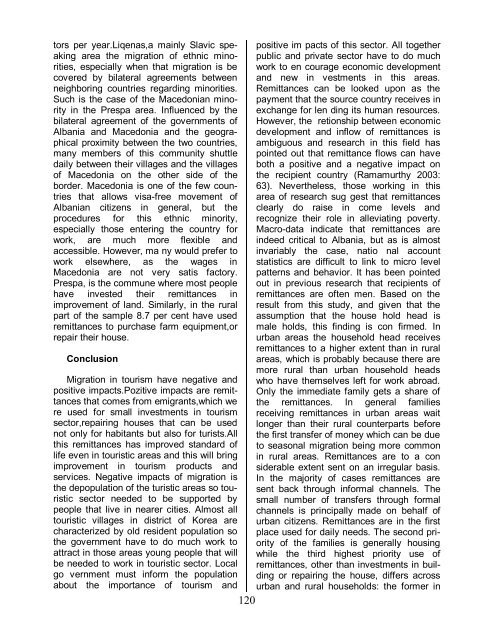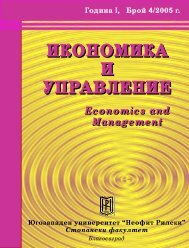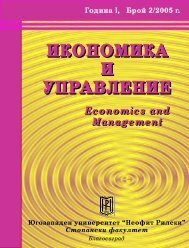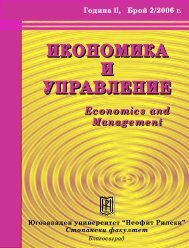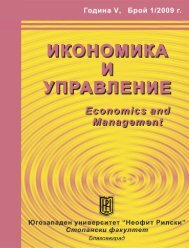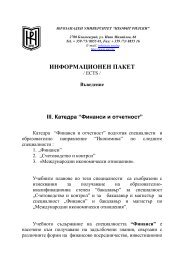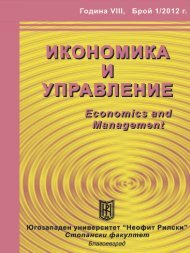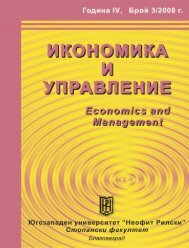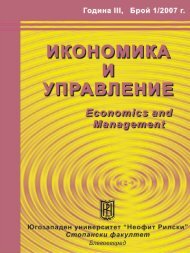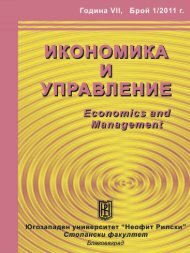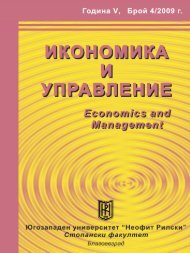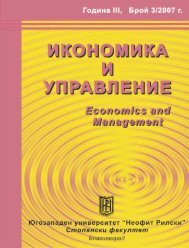ÐÑой 3/2011 - СÑопанÑки ÑакÑлÑÐµÑ - Югозападен ÑнивеÑÑиÑеÑ
ÐÑой 3/2011 - СÑопанÑки ÑакÑлÑÐµÑ - Югозападен ÑнивеÑÑиÑеÑ
ÐÑой 3/2011 - СÑопанÑки ÑакÑлÑÐµÑ - Югозападен ÑнивеÑÑиÑеÑ
Create successful ePaper yourself
Turn your PDF publications into a flip-book with our unique Google optimized e-Paper software.
tors per year.Liqenas,a mainly Slavic speaking<br />
area the migration of ethnic minorities,<br />
especially when that migration is be<br />
covered by bilateral agreements between<br />
neighboring countries regarding minorities.<br />
Such is the case of the Macedonian minority<br />
in the Prespa area. Influenced by the<br />
bilateral agreement of the governments of<br />
Albania and Macedonia and the geographical<br />
proximity between the two countries,<br />
many members of this community shuttle<br />
daily between their villages and the villages<br />
of Macedonia on the other side of the<br />
border. Macedonia is one of the few countries<br />
that allows visa-free movement of<br />
Albanian citizens in general, but the<br />
procedures for this ethnic minority,<br />
especially those entering the country for<br />
work, are much more flexible and<br />
accessible. However, ma ny would prefer to<br />
work elsewhere, as the wages in<br />
Macedonia are not very satis factory.<br />
Prespa, is the commune where most people<br />
have invested their remittances in<br />
improvement of land. Similarly, in the rural<br />
part of the sample 8.7 per cent have used<br />
remittances to purchase farm equipment,or<br />
repair their house.<br />
Conclusion<br />
Migration in tourism have negative and<br />
positive impacts.Pozitive impacts are remittances<br />
that comes from emigrants,which we<br />
re used for small investments in tourism<br />
sector,repairing houses that can be used<br />
not only for habitants but also for turists.All<br />
this remittances has improved standard of<br />
life even in touristic areas and this will bring<br />
improvement in tourism products and<br />
services. Negative impacts of migration is<br />
the depopulation of the turistic areas so touristic<br />
sector needed to be supported by<br />
people that live in nearer cities. Almost all<br />
touristic villages in district of Korea are<br />
characterized by old resident population so<br />
the government have to do much work to<br />
attract in those areas young people that will<br />
be needed to work in touristic sector. Local<br />
go vernment must inform the population<br />
about the importance of tourism and<br />
120<br />
positive im pacts of this sector. All together<br />
public and private sector have to do much<br />
work to en courage economic development<br />
and new in vestments in this areas.<br />
Remittances can be looked upon as the<br />
payment that the source country receives in<br />
exchange for len ding its human resources.<br />
However, the retionship between economic<br />
development and inflow of remittances is<br />
ambiguous and research in this field has<br />
pointed out that remittance flows can have<br />
both a positive and a negative impact on<br />
the recipient country (Ramamurthy 2003:<br />
63). Nevertheless, those working in this<br />
area of research sug gest that remittances<br />
clearly do raise in come levels and<br />
recognize their role in alleviating poverty.<br />
Macro-data indicate that remittances are<br />
indeed critical to Albania, but as is almost<br />
invariably the case, natio nal account<br />
statistics are difficult to link to micro level<br />
patterns and behavior. It has been pointed<br />
out in previous research that recipients of<br />
remittances are often men. Based on the<br />
result from this study, and given that the<br />
assumption that the house hold head is<br />
male holds, this finding is con firmed. In<br />
urban areas the household head receives<br />
remittances to a higher extent than in rural<br />
areas, which is probably because there are<br />
more rural than urban household heads<br />
who have themselves left for work abroad.<br />
Only the immediate family gets a share of<br />
the remittances. In general families<br />
receiving remittances in urban areas wait<br />
longer than their rural counterparts before<br />
the first transfer of money which can be due<br />
to seasonal migration being more common<br />
in rural areas. Remittances are to a con<br />
siderable extent sent on an irregular basis.<br />
In the majority of cases remittances are<br />
sent back through informal channels. The<br />
small number of transfers through formal<br />
channels is principally made on behalf of<br />
urban citizens. Remittances are in the first<br />
place used for daily needs. The second priority<br />
of the families is generally housing<br />
while the third highest priority use of<br />
remittances, other than investments in building<br />
or repairing the house, differs across<br />
urban and rural households: the former in


